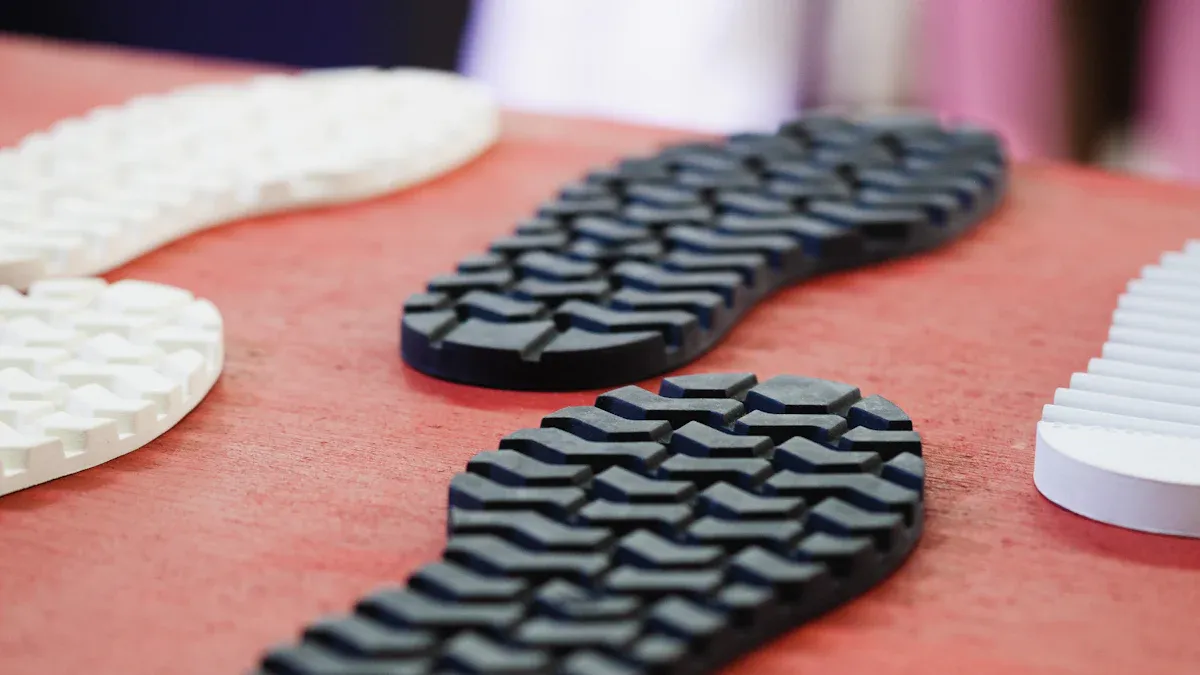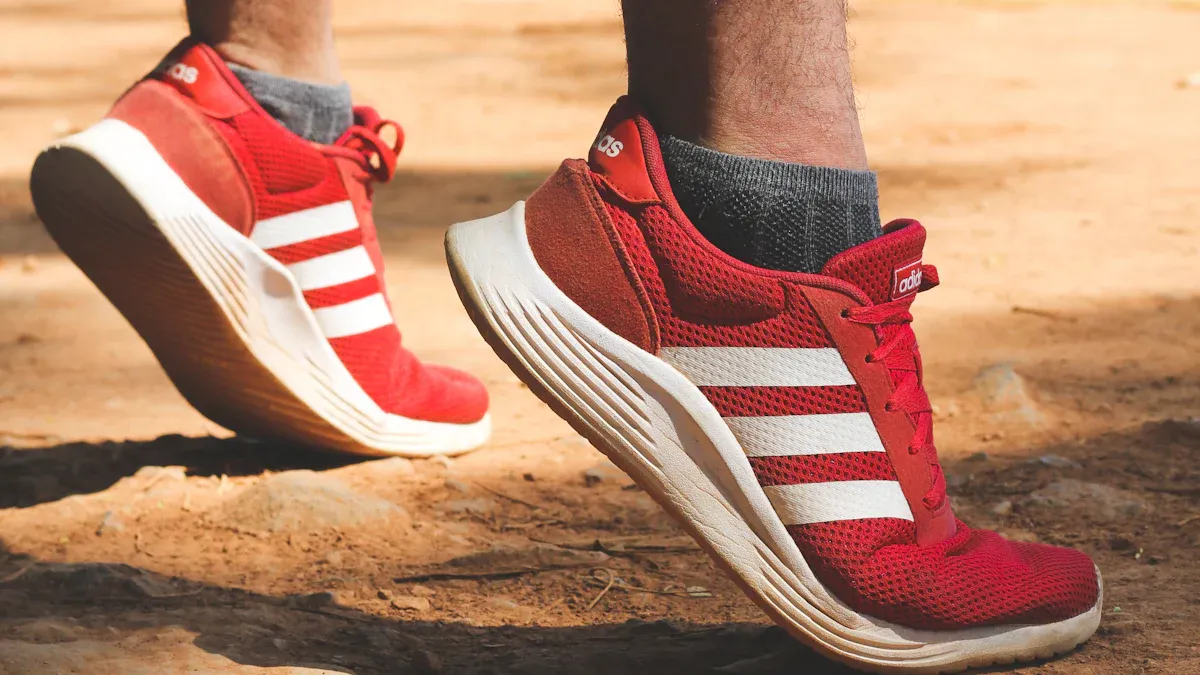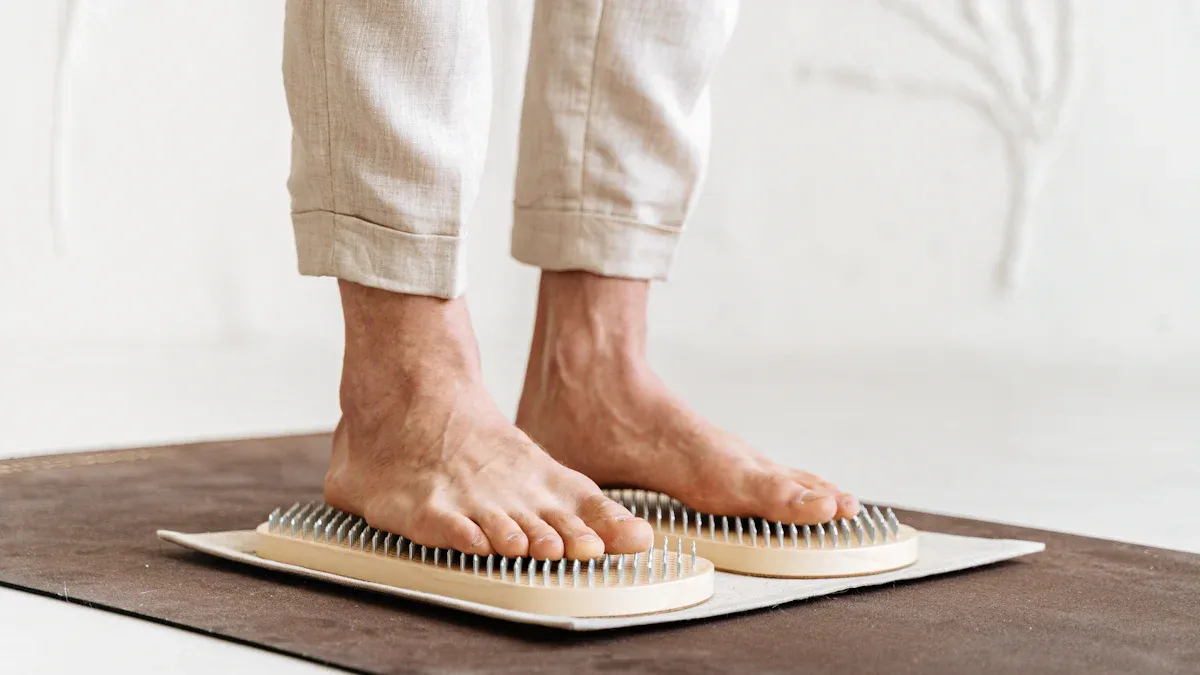How to Use Wholesale Insoles to Correct Leg Length Discrepancy

Leg length discrepancies affect a significant portion of the population. Studies show that about one-third of people have a discrepancy of at least 1 cm. Using wholesale insoles can effectively address this issue. These insoles provide the necessary support to balance your legs, enhancing your comfort and mobility. Correcting leg length discrepancies is crucial for maintaining proper posture and preventing discomfort during daily activities. By choosing the right insoles, you can take a proactive step towards better foot health and overall well-being.
Key Takeaways
Many people have different leg lengths. Wholesale insoles can help fix this. They make walking easier and more comfortable.
Pick the right insole for your needs. Height-increasing, arch support, and custom insoles each help with leg length differences.
Getting the right size is very important. Make sure they fit your shoes. Also, think about your foot's arch to stay comfortable.
Start using insoles slowly. Let your feet get used to them. Begin with short times and wear them longer as you feel okay.
Take care of your insoles and change them often. Replace them every 6 to 12 months. Do it more often if you do a lot of activities.
Understanding Leg Length Discrepancy

What is Leg Length Discrepancy
Leg length discrepancy (LLD) refers to a condition where one leg is shorter than the other. This difference can be subtle or significant. Discrepancies of less than 2 cm are often not considered problematic. However, when the difference exceeds 2 cm, it may warrant treatment consideration. Many people with discrepancies less than 2.0 cm do not perceive their condition as an issue. Yet, some individuals with discrepancies over 2.5 cm can still function well athletically.
Causes of Leg Length Discrepancy
Several factors contribute to leg length discrepancies. These can be categorized into structural and functional causes. Structural leg length discrepancies arise from measurable differences in long leg bones. Common causes include:
Hip joint diseases
Epiphyseal injury from childhood accidents
Tumors affecting growth plates
Malunion or non-union after trauma
Congenital malformations
Inflammation leading to overgrowth or shortening
Nerve damage affecting limb development
Idiopathic cases with no clear cause
Functional discrepancies may result from muscle imbalances or postural issues. For instance, damage to a growth plate can lead to premature bone growth cessation. Severe trauma, such as fractures from accidents, can also cause discrepancies.
Symptoms and Effects on Daily Life
Leg length discrepancies can significantly impact your daily activities. You may notice limping or an abnormal gait, which directly affects your mobility. These issues can hinder your ability to perform everyday tasks. Additionally, LLD can lead to posture problems, resulting in pain in the hips and back. Such discomfort can diminish your overall quality of life. Addressing leg length discrepancies early can help you maintain better mobility and comfort.
Types of Wholesale Insoles

When addressing leg length discrepancies, various types of wholesale insoles can provide effective solutions. Understanding these options helps you choose the best fit for your needs.
Height-Increasing Insoles
Height-increasing insoles are designed to add elevation to your footwear. They come in various thicknesses, allowing you to select the right height for your specific discrepancy. These insoles often feature a built-in lift or wedge that offsets height differences. This design ensures proper foot alignment and provides essential support.
Here are some benefits of height-increasing insoles:
Add Comfort: They cushion your feet and absorb shock, reducing fatigue during prolonged use.
Enhance Support: These insoles offer arch and heel support, crucial for maintaining proper foot alignment.
Improve Shoe Fit: They can help fill loose shoes, providing a more secure fit.
Arch Support Insoles
Arch support insoles play a vital role in correcting leg length discrepancies. They provide a precise fit tailored to your foot's unique shape. These insoles help balance differences in leg length, ensuring necessary support and alignment.
Key features of arch support insoles include:
Built-in Lift: They often include a lift or wedge to counter height differences effectively.
Cushioning: Adequate cushioning enhances comfort and stability, reducing strain on your lower limbs.
Customizable Options: Many arch support insoles come in various shapes and sizes, allowing you to find the perfect fit.
Customizable Insoles
Customizable insoles offer a tailored solution for your specific needs. You can adjust these insoles based on your foot shape, activity level, and shoe type. Consider the following factors when choosing customizable insoles:
Specific Needs: Evaluate your foot shape and any existing conditions.
Features: Look for cushioning, arch height, and materials that suit your lifestyle.
Professional Advice: Consulting with a podiatrist can help you select the most suitable insoles for your needs.
By understanding these types of wholesale insoles, you can make informed decisions to address leg length discrepancies effectively.
Choosing the Right Wholesale Insole
Assessing Your Needs
Before selecting a wholesale insole, you must assess your specific needs. Consider the degree of your leg length discrepancy. If you have a significant difference, you may require a thicker insole. Evaluate your daily activities as well. If you engage in sports or long hours of standing, opt for insoles that provide extra cushioning and support. Additionally, think about any existing foot conditions, such as flat feet or plantar fasciitis. These factors will guide you in choosing the right insole for your comfort and health.
Sizing and Fit Considerations
Proper sizing and fit are crucial for the effectiveness of your insoles. Here are some key considerations:
Insoles must fit the shoe size; they are often designed to be trimmed for a perfect fit.
3/4-length insoles are typically not designed to be trimmed and should match the shoe size range.
Placement of insoles is crucial; full-length insoles replace the shoe liner, while 3/4-length can be added without removal.
Matching insoles to arch types is essential to avoid discomfort and injury.
Taking these factors into account ensures that your insoles provide the necessary support and comfort.
Material Options
The materials used in wholesale insoles significantly impact their performance. Here’s a quick overview of common materials and their benefits:
Benefit | Description |
|---|---|
Superior Cushioning | EVA provides excellent shock absorption, enhancing comfort and reducing foot fatigue. |
Durability | EVA insoles withstand wear and tear, ensuring long-lasting performance. |
Lightweight and Flexible | The lightweight nature of EVA reduces foot burden, while flexibility allows adaptation to shoe shapes. |
Customization and Versatility | EVA can be tailored for specific needs, making it suitable for various applications. |
Cost-Effectiveness | Offers high performance at a lower cost compared to advanced materials, reducing replacement needs. |
Eco-Friendly Options | Many EVA insoles are produced with sustainable practices, appealing to environmentally conscious buyers. |
Easy Maintenance | EVA is moisture-resistant and easy to clean, providing convenience for users. |
Choosing the right material enhances your overall experience with the insoles, ensuring they meet your specific needs.
Practical Tips for Using Wholesale Insoles

Gradual Introduction
When you start using wholesale insoles, introduce them gradually. Begin by wearing them for short periods. This approach allows your feet to adjust to the new support. Increase the duration each day until you feel comfortable wearing them all day. This gradual introduction helps prevent discomfort and allows your body to adapt to the changes in alignment.
Pairing with Appropriate Footwear
Choosing the right footwear is essential for maximizing the benefits of your insoles. Here are some types of footwear that work well with insoles:
Footwear Type | Features |
|---|---|
Lace-up Sneakers | Snug fit with space for orthotics. |
Buckle Sandals | Adjustable fit for a chic summer look. |
Adjustable Flats | Practical and fashionable with elastic bands or adjustable straps. |
Sneakers | Removable insoles and well-cushioned soles for comfort. |
Boots | Depth for orthotic insoles, stylish for fall/winter outfits. |
Loafers & Flats | Versatile with removable insoles or extra cushioning. |
Sandals with Arch Support | Designed for orthotics, providing support in warm weather. |
Select footwear that accommodates your insoles comfortably. This choice enhances support and helps you maintain proper posture throughout the day.
Regular Maintenance and Replacement
To ensure your insoles remain effective, maintain and replace them regularly. Here are some guidelines:
Replace insoles every 6 to 12 months based on usage and foot mechanics.
For casual, everyday activities, consider replacing them every 6-12 months.
For high-impact sports, replace them every 3-6 months.
For work boots used during long shifts, replace insoles every 3-6 months.
Regular maintenance keeps your insoles in optimal condition, ensuring they continue to support your leg length discrepancy effectively.
Benefits of Using Wholesale Insoles
Improved Comfort
Using wholesale insoles significantly enhances your comfort. They provide additional cushioning that absorbs shock, making each step feel lighter. This cushioning helps alleviate pain from conditions like plantar fasciitis and bunions. You will notice that your feet feel more supported and stable, which maintains your natural foot arches. Here are some key benefits of improved comfort:
Enhanced cushioning properties for shock absorption.
Durable materials that retain their cushioning performance over time.
Lightweight design that reduces the burden on your feet.
Enhanced Mobility
Wholesale insoles also enhance your mobility, especially if you experience a leg length discrepancy. These insoles often incorporate built-in lifts or wedges to offset height differences. This design ensures proper foot alignment and alleviates strain on your lower limbs. With arch support and cushioning, you will enjoy greater stability and comfort. Breathable materials with moisture-wicking properties keep your feet dry during extended wear, further improving your mobility.
Long-Term Health Benefits
Investing in quality insoles can lead to significant long-term health benefits. They provide pain relief by reducing joint pain, which is especially beneficial for older adults and those with conditions like osteoarthritis. Additionally, insoles help lower the risk of injuries by providing cushioning and support, which reduces stress on your muscles and joints. Here are some long-term benefits to consider:
Improved posture by correcting imbalances in the feet.
Better weight distribution, leading to reduced stress on joints and muscles.
Enhanced athletic performance through increased shock absorption.
By using wholesale insoles, you not only address immediate discomfort but also invest in your long-term foot health.
Wholesale insoles offer a practical solution for correcting leg length discrepancies. They provide exceptional support and cushioning, which helps distribute body weight evenly across your feet. This design reduces pressure points and alleviates conditions like plantar fasciitis and arch pain. Additionally, these insoles absorb shock, minimizing fatigue during prolonged standing or walking.
Consider the following benefits of using wholesale insoles:
Easy maintenance ensures long-lasting use.
Superior cushioning improves overall comfort.
Customization options meet specific needs.
By choosing the right insoles, you can significantly improve your comfort and mobility.
FAQ
What should I look for when buying wholesale insoles?
When buying wholesale insoles, consider your specific needs, such as the degree of leg length discrepancy. Look for insoles with adequate cushioning, arch support, and the right size for your footwear.
How do I clean my wholesale insoles?
To clean your wholesale insoles, wash them with mild soap and a soft brush. Avoid drying them on a radiator. Instead, let them air dry to maintain their shape and integrity.
Can I use wholesale insoles in any type of shoe?
You can use wholesale insoles in most types of shoes, but ensure they fit properly. Choose shoes with removable insoles or enough depth to accommodate the added height and support.
How long do wholesale insoles last?
Wholesale insoles typically last between 6 to 12 months, depending on usage. For high-impact activities, consider replacing them every 3 to 6 months to maintain optimal support and comfort.
Will using insoles completely fix my leg length discrepancy?
While insoles can help alleviate discomfort and improve alignment, they may not completely correct leg length discrepancies. Consult a healthcare professional for a comprehensive treatment plan tailored to your needs.